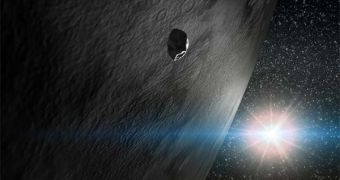Astronomers announced yesterday, April 28, that they managed to identify signs of water-ice on an asteroid for the first time ever. The finding is extremely important for our understanding of how Earth evolved shortly after it was formed. If more such space rocks are found carrying the precious stuff, then this would lend additional credence to the idea stating that our planet's oceans may be of extraterrestrial origins, as in formed from residues brought here by comets and asteroids. The recent discovery was verified by two independent science teams, Space reports.
The investigation was conducted on a space rock located in the Inner Asteroid Belt, which orbits the Sun between Mars and Jupiter. The asteroid 24 Themis was found to contain a layer of frost on its surface, which can only be water-ice, experts say. In addition to this amazing finding, the researchers also identified a number of organic compounds, which they say could constitute a basis for life in just the right mix. But the two groups stress that finding these interesting and promising molecules is by no means an indicator that life exists on this particular space rock.
Up until now, investigators believed that only comets contained the precious chemical, so vital for the development of life. One of the main reasons why comets hold water is because they orbit the Sun farther out in the solar system than the Inner Asteroid Belt. It was generally believed that asteroids beyond the orbit of Mars were too close to the star to allow for ice to endure on their surface. Still, astronomers suspect that Ceres, the largest asteroids known, contains large amounts of the stuff, but concealed under a layer of dust and other rocky debris.
Using spectrometers to assess the traits of the light bouncing off of 24 Themis, investigators concluded that the 123-mile (198-kilometers) asteroid must be covered in a layer of ice. “This is the first time we've actually seen ice – literally H20 – on an asteroid,” explains Johns Hopkins University expert Andrew Rivkin, who was also one of the leaders for the new study. Both studies were conducted using the Mauna Kea, Hawaii-based NASA Infrared Telescope Facility. Details were published in two separate papers, both appearing in the April 29 issue of the highly-regarded scientific journal Nature.

 14 DAY TRIAL //
14 DAY TRIAL //